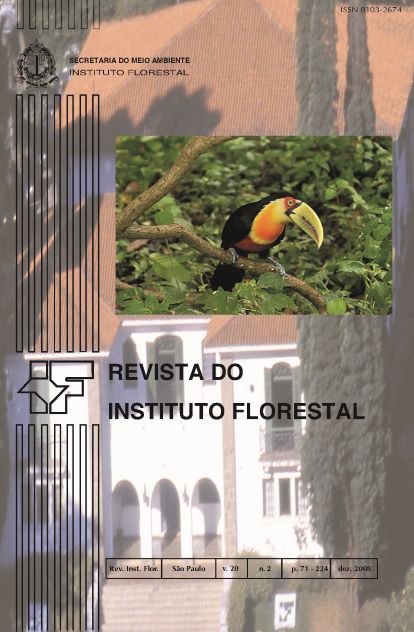VARIAÇÃO GENÉTICA PARA A DENSIDADE BÁSICA DA MADEIRA E CARACTERES SILVICULTURAIS EM UMA POPULAÇÃO BASE DE Eucalyptus camaldulensis DEHNH
DOI:
https://doi.org/10.24278/2178-5031.2008202371Palavras-chave:
variabilidade genética, herdabilidade, ganho genético, melhoramento florestal, reflorestamentoResumo
Os objetivos deste trabalho foram determinar a variação genética e estimar os ganhos esperados na seleção para caracteres de crescimento, forma do fuste - FOR e densidade básica da madeira - DB em uma população base de E. camaldulensis procedente da Austrália, visando a sua transformação em uma Área de Produção de Sementes - APS. Os caracteres de crescimento avaliados foram: diâmetro à altura do peito - DAP, altura total - ALT, volume - VOL, altura da bifurcação - AB e brotação de cepa - BC. Foram detectadas diferenças significativas entre progênies para todos os caracteres estudados, exceto para os caracteres relacionados à densidade básica, e altos coeficientes de variação genética para os caracteres de crescimento, o que sugere a existência de variabilidade genética na população base e a possibilidade de melhoramento genético pela seleção das melhores progênies. As herdabilidades, em nível de plantas individuais, foram medianas para os caracteres AB, FOR e DB na posição intermediária (0,20, 0,16 e 0,49, respectivamente) e baixas para os demais caracteres. Já as herdabilidades em nível de médias de progênies variaram de médias para DB a altas para todos os demais caracteres, demonstrando um alto controle genético na variação fenotípica desses caracteres. A eficiência no ganho da seleção foi estimada para DB na posição intermediária e comparada para três estratégias de seleção, utilizando-se o índice de Multi-efeitos: i) seleção massal no experimento; ii) seleção massal dentro de progênies e; iii) seleção entre e dentro de progênies. Observou-se que, tanto a seleção massal no experimento quanto a seleção entre e dentro de progênies tiveram maior eficiência do que a seleção massal apenas dentro de progênies. Finalmente, os resultados indicaram que esta população base de E. camaldulensis tem potencial para ser transformado em APS.
Downloads
Referências
ARGANBRIGHT, D. G. Influence of extractives on bending strength of redwood (Sequoia sempervirens). Wood and Fiber Science, Madison, v. 2, n. 4, p. 367-372, 1971.
CAIXETA, R. P. et al. Variações genéticas em populações de Eucalyptus spp. detectadas por meio de marcadores moleculares. Revista Árvore, Viçosa−MG, v. 27, n. 3, p. 357-363, 2003.
DOWNES, G. M. et. al. Sampling plantation eucalypts for wood and fibre properties. Melbourne: CSIRO Publishing, 1997. 132 p.
FERREIRA, J. E. M. et al. Teste de procedência de Eucalyptus para a região subúmida do Estado do Maranhão. Boletim de Pesquisa Florestal, Colombo, v. 15, p. 41-48, 1987.
FOELKEL, C. E. B.; BRASIL, M. A. M; BARRICHELO, L. E. G. Métodos para determinação da densidade básica de cavacos para coníferas e folhosas. IPEF, Piracicaba, n. 2/3, p. 65-74, 1971.
GRATTAPAGLIA, D. Integrating genomics into Eucalyptus breeding. Genetics and Molecular Research, Ribeirão Preto, v. 3, n. 3, p. 369-379, 2004.
LIMA, P. C. F. Espécies potenciais para reflorestamento em regiões semi-áridas. Silvicultura, São Paulo, v.10, n. 37, p. 28-32, 1984.
MARTINS, I. S.; PIRES, I. E.; OLIVEIRA, M. C. Divergência genética em progênies de uma população de Eucalyptus camaldulensis Dehnh. Floresta e Ambiente, Rio de Janeiro, v. 9, n. 1, p. 81-89, 2002.
MITCHEL, H. L. Wood quality evaluation from increment cores. Tappi, Atlanta, v. 41, n. 4, p. 150-156, 1958.
MORAES, M. A. et al.Variação genética para caracteres silviculturais em progênies de polinização aberta de Eucalyptus camaldulensis em Luiz Antônio−SP. Rev. Inst. Flor., São Paulo, v. 19, n. 2, p. 113-118, 2007.
MORI, E. S. Variabilidade genética isoenzimática em uma população de Eucalyptus grandis Hill ex Maiden submetida a diferentes intensidades de seleção. 1993. 119 f. Tese (Doutorado em Genética) - Escola Superior de Agricultura “Luiz de Queiroz”, Universidade de São Paulo, Piracicaba.
NIETO, V. M.; RODRIGUEZ, J. Eucalyptus camaldulensis Dehnh. In: VOZZO, J. A. Tropical Tree Seed Manual. Part II – Species descriptions. Washington, D.C.: USDA Forest Service, 2003. p. 466-467.
OLIVEIRA, J. T. S.; SILVA, J. C. Variação radial da retratibilidade e densidade básica da madeira de Eucalyptus saligna Sm. Revista Árvore, Viçosa−MG, v. 27, n. 3, p. 381-385, 2003.
PRYOR, L. D. Biology of Eucalyptus. London: Esward Arnold, 1976. 82 p.
RESENDE, M. D. V. Melhoramento de essências florestais. In: BORÉM, A. (Ed.). Melhoramento de espécies cultivadas. Viçosa−MG: Universidade Federal de Viçosa, 1999. p. 589-647.
______. Genética biométrica e estatística no melhoramento de plantas perenes. Brasília, DF: EMBRAPA Informação Tecnológica, 2002a. 975 p.
______. Software SELEGEN - REML/BLUP. Colombo. EMBRAPA – CNPF, 2002b. 67 p. (Série documentos, 77).
SANTOS, P. E. T.; GERALDI, I. O.; GARCIA, J. N. Estimates of genetic parameters of wood traits for sawn timber production in Eucalyptus grandis. Genetics Molecular Biology, Ribeirão Preto, v. 27, n. 4, p. 567-573. 2004.
SCANAVACA JUNIOR, L.; GARCIA, J. N. Determinação das propriedades físicas e mecânicas da madeira de Eucalyptus urophylla. Scientia Forestalis, Piracicaba, n. 65, p. 120-129, 2004.
STURION, J. A. et al. Variação da densidade básica da madeira de doze espécies de Eucalyptus plantadas em Uberaba, MG. Boletim de Pesquisa Florestal, Colombo, n. 14, p. 28-38, 1987.
WEI, R. P.; LINDGREN, D. Effective family number following selection with restrictions. Biometrics, Arlington, v. 52, p. 198-208, 1996.
ZOBEL, B.; TALBERT, J. Applied forest tree improvement. New York: John Wiley & Sons, 1984. 496 p.















